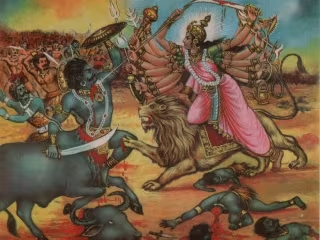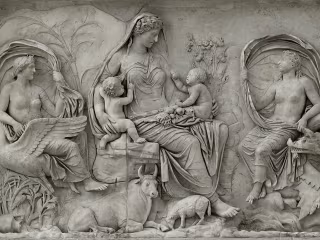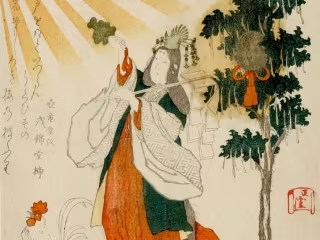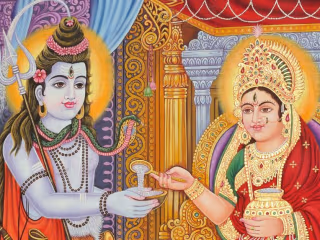Benzaiten: Goddess of Love and Luck
0
Ghostwriter
Blog Writer
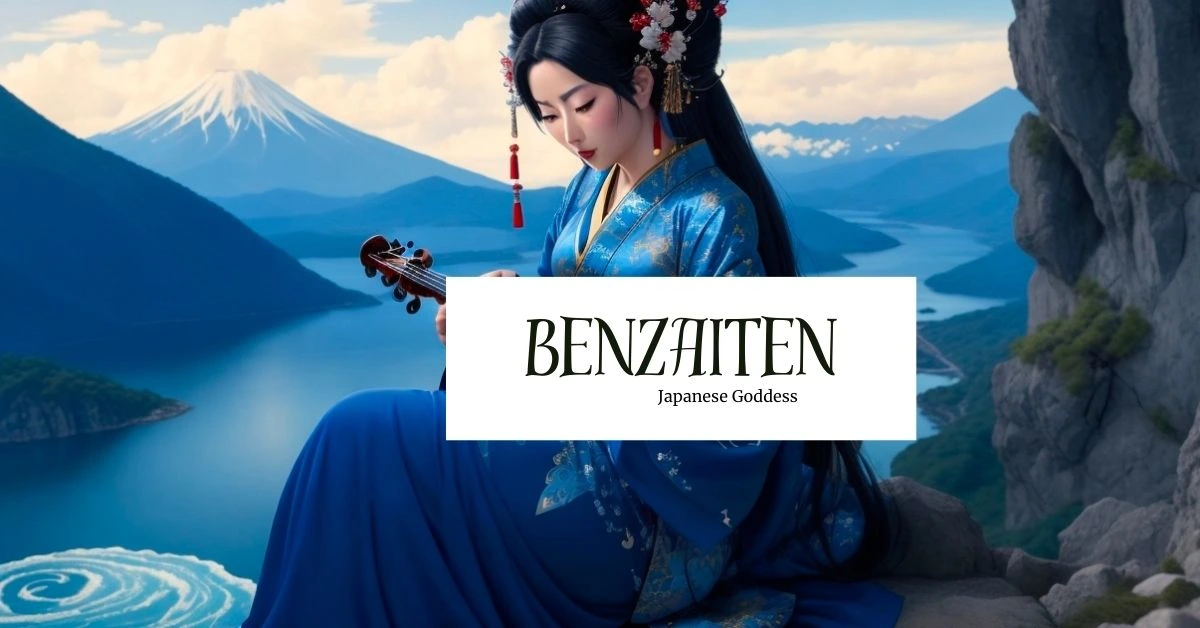
In the rich tapestry of Japanese mythology, there is the Japanese goddess Benzaiten. As goddess of all that moves and flows, Benzaiten is the Shinto kami of lakes, rivers, and the sea. However, her domain extends beyond just the realm of water, as she is also the goddess of eloquence, music, poetry, speech, and wealth. Throughout history, Benzaiten has been the subject of various literary works, from The Legend of Enoshima to the 14th-century Noh play entitled Chikubushima. Whether it is the power of her words, the beauty of her music, or the wisdom of her teachings, Benzaiten is a figure who has left an indelible mark on the people of Japan, and her legacy continues to inspire and guide them to this day.
Overview of Benzaiten
The Shinto deity has many names: Benzaiten, Benza-tennyo, and Benai-ten, but most call her Benten. Originating as a manifestation of the Indian goddess Sarasvati, Benten has evolved, adapting to different landscapes, regions, and historical periods (Writers). Throughout the centuries, Benzaiten has emerged as a prominent emblem of religious syncretism within Japanese culture, seamlessly integrating elements from diverse religious traditions: she is a goddess in the two major religions of Japan, Shinto, and Buddhism. As a result, she has become an enduring symbol of Japan’s unique blend of cultural influences. Her influence can be seen in everything from art and literature to popular culture and daily life, making her an influential figure for spiritual and secular Japanese communities.
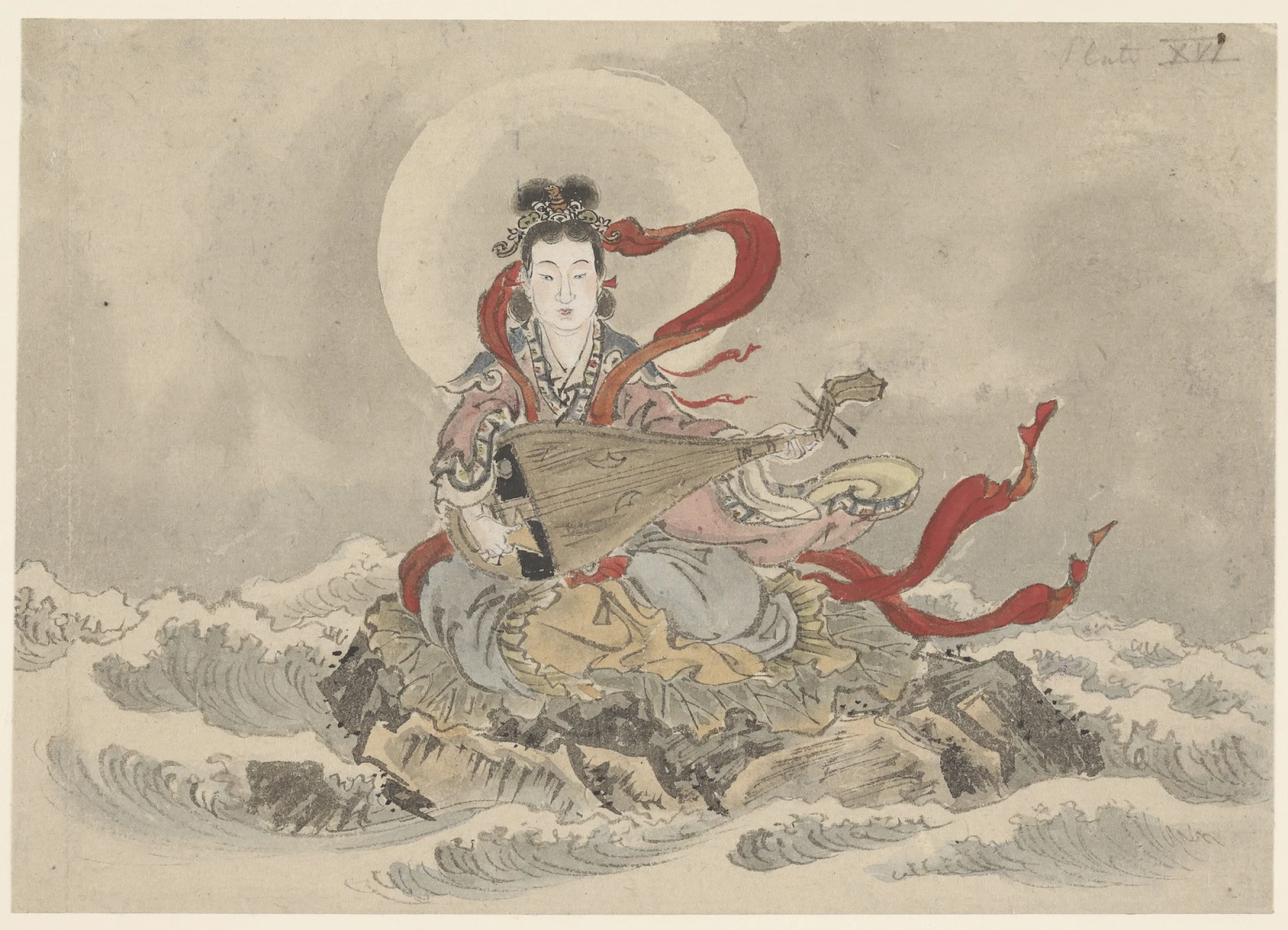
National Museum of Asian Art - The artist Kawanabe Kyōsai (1831-1889) created this image of the goddess Benten playing a biwa on top of a mountain beneath the moon. The woman is dressed in robes of gray, mustard, and red and is adorned with jewelry. The piece was created during the Meiji era in the 1880s.
Titles
Goddess of Love and Luck
Benzaitennyo (Goddess who dispenses wisdom) (“Benzaiten”)
Myoonten, (Goddess of Wonderful Sounds) (“Benzaiten”)
Ichikishima-hime-no-mikoto (Heavenly Princess Ichikishima) (“Benzaiten”)
Abilities
The Japanese goddess Benzaiten is both a Buddhist goddess and a Shinto Kami. As a goddess of love and luck, she is renowned for her association with luck and wisdom, bestowing insightful counsel and good fortune upon those she favors. As the only female deity in the group of Seven Lucky Gods, she spreads prosperity, compassion, and auspiciousness among the people of Japan alongside the other six lucky gods.
Characteristics
Benten, a revered deity, is often portrayed as a stunning female figure, embodying the quintessence of beauty and femininity. Her attire varies in different portrayals, ranging from a courtesan’s attire to the modest robes of a nun. However, her most notable symbol is the biwa, a traditional Japanese flute-like instrument, which signifies her association with music and the arts. In addition to her musical abilities, her depictions display varied Buddhist halos and other sacred symbols that highlight her divine nature and spiritual importance (“Benzaiten”).
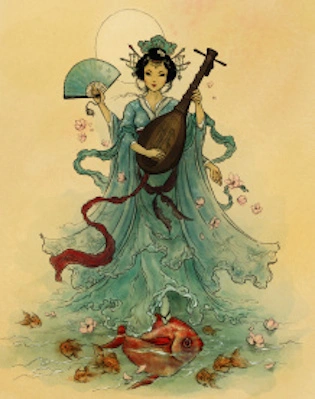
Source: Girlmuseum -
Traits
The character of Benten shares many similarities with Sarasvati, a goddess from Indian mythology (Fisher). Both revered figures are known for their association with wisdom, learning, and knowledge, Benzaiten, in particular, is known for her compassionate and merciful nature. Along with her generosity, Benten is revered for showing kindness and empathy towards her followers, granting them blessings and protection in times of need.
Symbols
Benzaiten is associated with many symbols, which signify her distinct roles as a Shinto deity. Her central symbol, however, is water. Followers of japanese goddess benzaiten believe that she has control over water and influence over the tides: her affinity with water is why her shrines are near lakes and rivers. Another symbol is the biwa which represents her association with music, art, and creativity. Benten’s connection to art and music is in the many festivals held in her honor, which feature performances and displays of artistic expression. Overall, the symbols associated with Benzaiten reflect her multifaceted nature and how she has influenced Japanese culture and society.

Wikipedia - The goddess of luck and love is depicted playing a biwa while being encircled by a dragon. In her flowing grey robes, Benten wears a headpiece adorned with jewels.
Festivals and Rituals
Even today in Japan, numerous shrines dedicated to Benzaiten can be found, with the three most prominent being the Itsukushima Shrine located in Hiroshima prefecture, the Enoshima Shrine situated in Kanagawa prefecture, and the Hogan-ji Temple located in Shiga Prefecture. The famous Legend of Enoshima took place on Enoshima Island, where the Zeniarai Benten Ugafuku Shrine is. The cave shrine is one of the remaining shrines in Japan that uniquely blends Buddhism and Shinto practices, making it a truly unique experience for all visitors (link et al.).
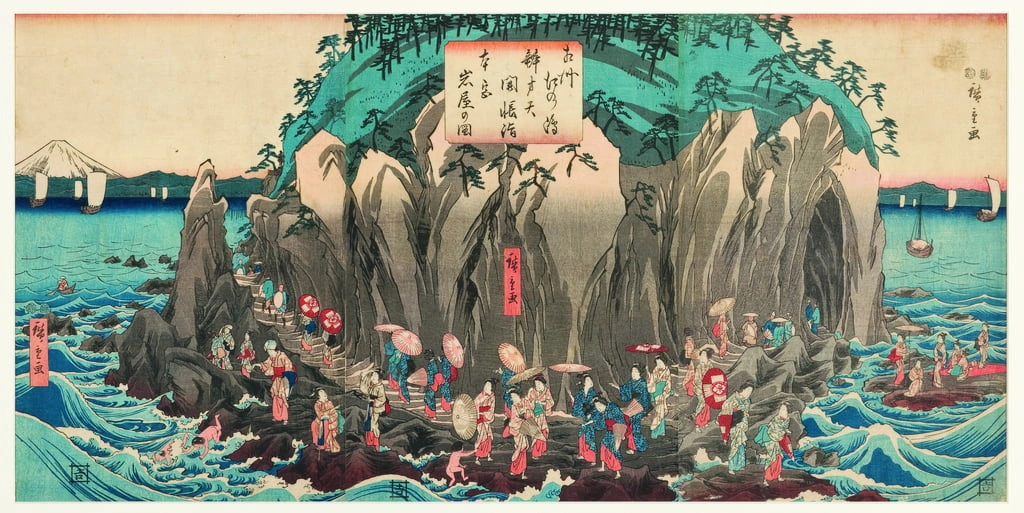
Meisterdrucke - In this illustration, people are going on pilgrimage to the cave and Shrine of Benzaiten at Enoshima, Sagami, c.1850-51.
Legends associated with Benzaiten
Originating from Hinduism, Benten is a revered figure in both Shinto and Buddhism. As such, she has a plethora of legends associated with her, each reflecting the diverse cultures and religions from which she draws her influence. For our purposes, we will be delving into Benzaiten’s role in Japanese Mythology, specifically through the famous Legend of Enoshima and the 14th-century Noh play entitled Chikubushima. By exploring these tales, we better understand the complex and intriguing nature of the goddess of love and luck.
Origin story
The goddess Benten is a revered figure in Shinto and Buddhism, but she was born from Hinduism. The goddess has roots that trace back to the Indian goddess Sarasvati. Interestingly, Benzaiten is a Chinese interpretation of Sarasvati’s name, as found in the Golden Light Sutra, highlighting the goddess’s global significance (Writers). Like Sarasvati, Benten is known for her many virtues, including wisdom, love, and beauty. Moreover, despite originating from a religious background not native to Japan, the Shinto deity integrated seamlessly into Japan’s culture over time.
Benzaiten first arrived in Japan during the Asuka period, from 538 to 710. During this time, Buddhism and the Golden Light Sutra had also reached Japan, and Benten’s presence was noted by 552 when a comet associated with her brought good fortune to Japan. As Buddhism gained popularity among the Imperial Family, so did Benzaiten’s worship. She became one of the Seven Lucky Gods, and nobles and peasants worshiped her. In certain regions, she was merged with local kami related to rivers and islands, further cementing her place in Japanese mythology and culture. Over time Benten’s popularity grew, particularly among urban dwellers such as court musicians and courtesans. During the Tokugawa era, from 1600 to 1868, Benzaiten became associated with wisdom, a virtue for the ruling samurai class. Despite the demonization of Buddhism as a “foreign religion” during the Meiji Restoration and the rise of State Shinto, Benten’s devotees remained intact. Her well-developed roots in Shinto traditions and Japanese culture allowed her to face less neglect when compared to other foreign religious influences (Writers).
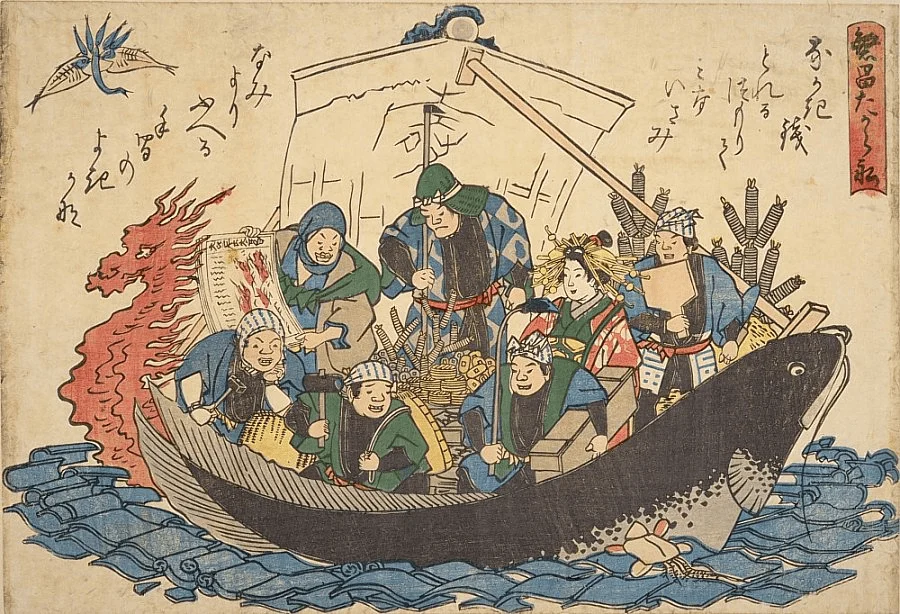
Onmarkproductions - In this illustration, all seven lucky gods are enjoying themselves while sailing on a ship, and Benzaiten is clearly visible in the midst of the chaos.
The Legend of Enoshima
According to the Enoshima Engi, an ancient Japanese historical document, the Koshigoe region was once plagued by violent storms and constant earthquakes. However, the chaos eventually stopped, and a divine maiden descended from the heavens. As she was about to touch the water near Koshigoe’s southern shores, an island emerged from the depths and became her new abode. This island, Enoshima, is now widely believed to be the dwelling place of the revered deity Benten, who is associated with various domains such as water, speech, music, and knowledge (Kimball).
As the legend goes, upon Benzaiten’s arrival, a dragon named Gozuryu caught sight of her and was immediately captivated by her beauty. He proposed marriage, but Benten knew of his terrible nature and demanded that he vow to assist the people of Koshigoe. From then on, Gozuryu devoted himself to protecting the area he once tormented. As time passed, Benzaiten recognized Gozuryu’s genuine efforts, and together they nurtured Koshigoe into a flourishing community (Kimball).
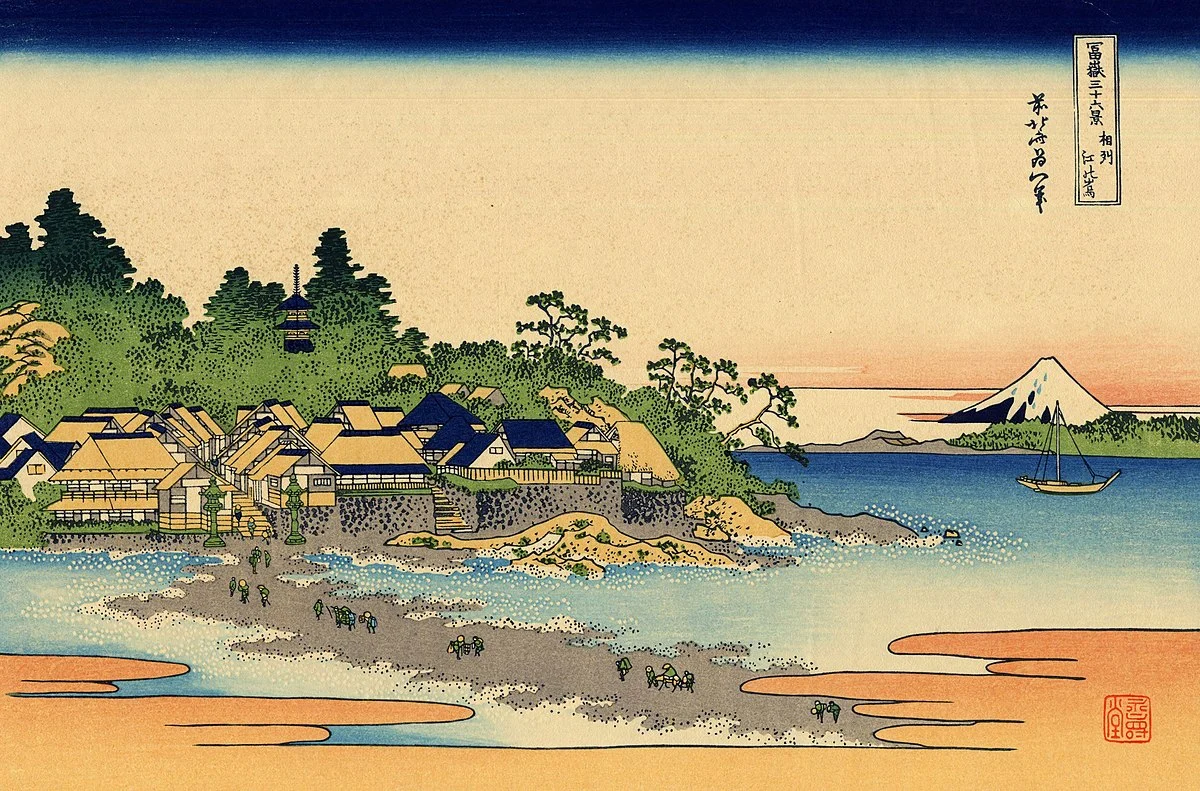
Wikipedia - This is an illustration of the Japanese island of Honshu’s Pacific Coast, Enoshima Island. Traditional Japanese homes with yellow roofs are depicted in the illustration beside the seashore and beach, while a mountain can be seen in the background.
Chikubushima
The 10th-century Noh play “Chikubushima,” tells the story of a court official from the late 9th century who embarks on a pilgrimage to the island of Chikubushima to pay homage to the goddess Benten. As he arrives at the shore of the lake, he comes across an elderly fisherman and a young woman preparing to set sail in a fishing boat. The court official is intrigued and requests to join them on their journey. The fisherman and the young woman kindly agree to his request (Fisher).
Upon reaching the island, the fisherman acts as the court official’s guide, leading him to the shrine of Benzaiten. The court official is amazed by the shrine’s magnificent beauty, but his admiration is short-lived when he sees the young woman approaching the shrine. He is displeased by an ordinary woman from a lower social class visiting such a sacred place and feels offended. In response to the court official’s disdainful behavior, the old fisherman gently reproaches him, reminding him that Benzaiten does not discriminate based on social status or gender. The goddess welcomes all who come to pay their respects, as she is a woman (Fisher).
It becomes clear that the fisherman and the youthful woman are not human. The woman gracefully vanishes behind a door, only to reappear as the revered deity, Benten. Meanwhile, the fisherman plunges into the vast ocean, summoning Ryujin, the Dragon King of the Sea. The Dragon King then dutifully appears before the official before returning to his opulent underwater palace, having fulfilled his responsibility of safely escorting the goddess back to her holy temple (Fisher).
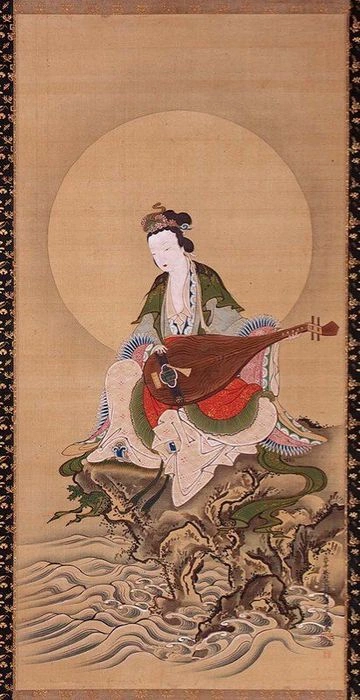
Pinterest - In this illustration, Benzaiten is depicted sitting on rocks above the water and playing a biwa. A silhouette of the sun can be seen in the background, and she is dressed in luxurious robes.
Influences of other religions/cultures on the Japanese goddess Benzaiten
Benzaiten, a syncretic deity, is held in high esteem as a revered deity in the Shinto religion and Buddhism, two of Japan’s most popular religions. As a Buddhist deity, she has roots in Indian and Chinese traditions, particularly with Saraswati, the Hindu goddess of knowledge, arts, and music. Benzaiten’s influence, however, has extended beyond these religious traditions and has been shaped by other religious and folk beliefs over time.
In Shinto, Benten is a kami, a concept that refers to spirits or deities associated with natural phenomena. She is worshiped at Shinto shrines alongside other Shinto deities, signifying the influence of Shintoism on Benzaiten’s syncretic identity. Implementing different elements from different religions and belief systems into her identity has contributed to Benten’s adaptability, making her a prominent figure in Japanese spirituality and culture.
Modern appearances
Benzaiten is a popular figure who has made a couple of appearances in various forms of pop culture. Fans may recognize her from the manga series Noragami or Akatsuki!! Otokojuku, as well as the popular video game Yo-Kai Watch (“Benzaiten”).
Final thoughts
Benten is a deity of great complexity and depth and encompasses a rich tapestry of religious and cultural influences. Taking inspiration from the Hindu goddess Saraswati and having roots in Japanese Buddhist traditions, she is the product of varying religious and folk beliefs. As a syncretic deity, she embodies the fusion of various concepts and symbols, representing numerous essential aspects of life, including water, music, arts, knowledge, and protection. Benzaiten’s inclusive nature welcomes worshipers of all social statuses and genders, transcending boundaries and fostering a profound connection with the divine. Her legends and stories continue to inspire devotion and reverence, symbolizing the harmonious integration of different religious and cultural traditions in Japan, a testament to the rich tapestry of this fascinating culture.
References
“Benzaiten.” Mythopedia, mythopedia.com/topics/benzaiten.
Fisher, Martini. “Unveiling the Mysteries of Benzaiten, Goddess of War, Music, and Culture.” Martini Fisher, 8 Feb. 2023, martinifisher.com/2023/02/08/unveiling-the-mysteries-of-benzaiten-goddess-of-war-music-and-culture/.
Kimball, Donny. “The Legend of Enoshima | the Tale of Gozuryu & Benzaiten | a Different Side of Japan.” Medium, A Different Side of Japan, 30 June 2017, donnykimball.com/enoshima-2f4a58d547ce. Accessed 27 June 2023.
link, Get, et al. Benzaiten. www.curiousordinary.com/2018/06/benzaiten.html. Accessed 27 June 2023.
Writers, YABAI. “Benzaiten (Benten): Japan’s Goddess of Reason | YABAI – the Modern, Vibrant Face of Japan.” YABAI, yabai.com/p/3200.
Did we miss something? Do you know another aspect of this legend? Don't hesitate to reach out!
Like this project
0
Posted Sep 16, 2023
A client hired me to write several informative pieces on Japanese Goddesses, and this blog post centers around the Goddess of Love and Luck, Benzaiten.
Likes
0
Views
1186
Tags
Ghostwriter
Blog Writer


